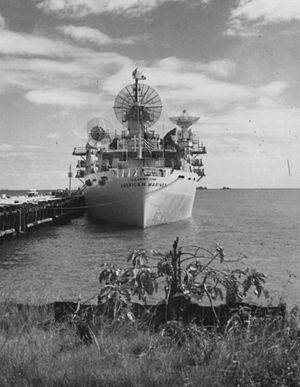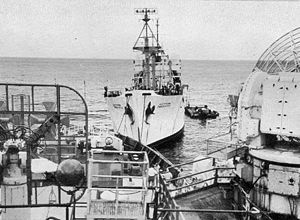Missile Range Instrumentation Ship
Missile Range Instrumentation Ships, Range Ships, or Tracking Ships, are ships equipped with antennas and electronics to support the launching and tracking of missiles and rockets. Since many missile ranges launch over ocean areas for safety reasons, the Range Ships extend the range of shore based tracking facilities.
In the United States the initial Tracking Ships were constructed by the US Army and then US Air Force to support their Missile Programs. They were generally built on a surplus Liberty ship or Victory ship hull. By 1964 the US Navy took over all the Range Ships and introduced more.
There are currently only two active Instrumentation Ships in the US Navy inventory: USNS Observation Island (T-AGM-23) and USNS Invincible(T-AGM-24).[1] USNS Howard O. Lorenzen (T-AGM-25)[2] is due to be delivered in 2010 and is slated to replace USNS Observation Island.[3]
Contents
Missile range instrumentation ships
The Chinese ships were purpose built vessels for their role in the navy and the space program.
- Yuanwang class
- Yuanwang 1 1977-present
- Yuanwang 2 1978-present
- Yuanwang 3 1995-present
- Yuanwang 4 1999-present
- Yuanwang 5 2007-present
- Yuanwang 6 2007-present
The Poincaré was a converted tanker, but the Monge was a purpose built ship.
Inactive
Active
- Monge class (A601) 1992-present[5]
The Soviet and later Russian ships were purpose built vessels for their role.
- Akademik Sergei Korolev 1970-1996 (scrapped)
- Kosmonaut Yuri Gagarin 1971-1991 (scrapped)
- Soviet command ship SSV-33 1989-2001 (laid up)
Most of the USN and USAF tracking ships were converted into their role. Some ships were in service with NASA
Inactive
- USNS Range Tracker (T-AGM-1) 1961-1969 - built as transport/freighter
- USNS Range Recoverer (T-AGM-2) 1960-1972 - built for US Army
- USNS Longview (T-AGM-3) 1959-19? - merchant ship
- USNS Richfield (T-AGM-4) 1960-1968 - cargo and passenger ship
- USNS Sunnyvale (T-AGM-5) 1960-1974 - cargo ship
- USNS Watertown (T-AGM-6) 1960-1972 - cargo and passenger ship
- USNS Huntsville (T-AGM-7) 1960-1974 - merchant ship
- USNS Wheeling (T-AGM-8) 1962-1990 - cargo ship
- USNS General H. H. Arnold (T-AGM-9) 1961-1982 - troop ship
- USNS General Hoyt S. Vandenberg (T-AGM-10) 1963-1983 - troop ship
- USNS Twin Falls (T-AGM-11) 1964-1972 - merchant ship
- USNS American Mariner (T-AGM-12) 1959-1966 - US Coast Guard training ship
- USNS Sword Knot (T-AGM-13) 1950s-1982 - purpose built ship for US Air Force
- USNS Rose Knot (T-AGM-14) 1950s-1969 - purpose built ship for US Air Force
- USNS Coastal Sentry (T-AGM-15) late 1950s-1972 - USN cargo ship
- USNS Coastal Crusader (T-AGM-16) late 1950s-1976 - merchant ship
- USNS Timber Hitch (T-AGM-17) 1964-1969 - purpose built ship for US Air Force
- USNS Sampan Hitch (T-AGM-18) 1964-1973 - purpose built ship for US Air Force
- USNS Vanguard (T-AGM-19) 1964-1999 - merchant marine tanker/supplies ship
- USNS Redstone (T-AGM-20) 1964-? - merchant marine tanker/supplies ship
- USNS Mercury (T‑AGM‑21) 1964-1974? - merchant marine tanker/supplies ship
- USNS Range Sentinel (T-AGM-22) 1969-1974 - USN shakedown training ship/military cargo ship
Active
- USNS Observation Island (T-AGM-23) 1977-present - military merchant ship
- USNS Invincible(T-AGM-24) 2000-present - research ship
Planned
- USNS Howard O. Lorenzen (T-AGM-25) Due to be delivered in 2010; purpose built to replace Observation Island.
See also
References
- ↑ "Military Sealift Command Fact Sheet" (htm). http://www.msc.navy.mil/factsheet/t-agm.htm. Retrieved 2008-02-10.
- ↑ "Range Instrumentation Ship Photo Index". http://www.navsource.org/archives/09/53/5325.htm. Retrieved 2009-04-04.
- ↑ "SIU - Keel laid for future USNS Observation Island replacement (8/25)". http://www.seafarers.org/HeardAtHQ/2008/Q3/keel.xml. Retrieved 2009-04-04.
- ↑ Poincare
- ↑ Monge


